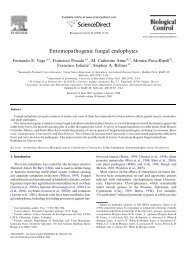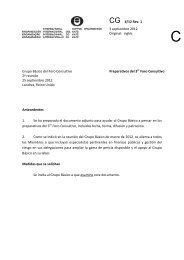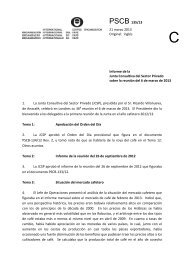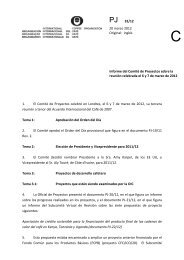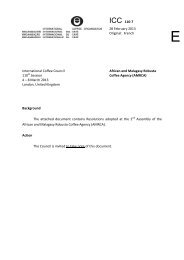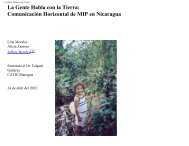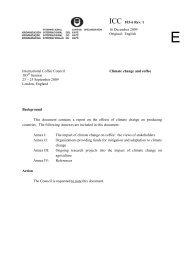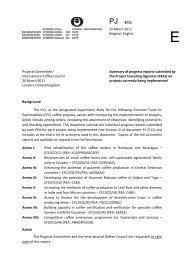Devouring profit - International Coffee Organization
Devouring profit - International Coffee Organization
Devouring profit - International Coffee Organization
You also want an ePaper? Increase the reach of your titles
YUMPU automatically turns print PDFs into web optimized ePapers that Google loves.
Table 12. Main problems in coffee production, Ejido Sta. Rosalia.<br />
Problems (not ranked)<br />
Lack of economic resources<br />
High transportation costs, due to distance between farm & selling point<br />
Low coffee prices<br />
Lack of government support<br />
Mycena citricolor)<br />
crop. A key point is that average productivity is only about 10.5 qq of parchment<br />
coffee per hectare, similar to the national average. The density of trees per hectare<br />
suggests the coffee production in this locality is intermediate (between traditional,-<br />
1500 to 2000 trees/ha, and intensive, - at least 4000 trees/ha). Each year they<br />
renew an average of 370 coffee trees per hectare (range 200 to 500), which demonstrates<br />
interest in having new trees even though crop management is not intensive.<br />
Regarding coffee varieties, they prefer the traditional Borbon and Typica, observing<br />
that a coffee tree is considered old when it is more than 50 years old. In the case of<br />
Caturra or Catimor varieties on the other hand, trees over 12 years are considered as<br />
old and unproductive. We developed a work calendar with the farmers, from which<br />
we estimated total labour needs at about 200 working days/ha distributed throughout<br />
the year, presenting a peak in November due to the coffee harvest. Labour requirements<br />
are significantly less than would be the case with intensive production.<br />
They commented that the “coyotes” (private buyers) check the coffee and mark down<br />
the price for poor quality. If the coffee farmer does not control CBB, price reductions<br />
can be about 8 to 10%; moreover it can be further affected by a weight reduction of<br />
around 2 kg in a 60 kg sack. In both cases this is a significant amount of money for<br />
them to lose.<br />
The role of the intermediary: Belisario Dominguez is the name of a village where<br />
most local coffee farmers sell their coffee to intermediaries. In this place Mr. Juventino<br />
Velásquez, a local coffee trader, was interviewed. He has been buying coffee for more<br />
than 15 years; sometimes he also lends money to farmers. Normally he works with a<br />
capital of $100,000 Mexican pesos, which can be distributed among 20 farmers, i.e.<br />
an average of $5,000 per person (about US$500). The interest rate he charges is about<br />
5% per month, which was six times the national Mexican inflation rate. At the beginning<br />
of harvest, farmers often lack funds so they are more or less forced to approach<br />
the intermediaries. But he is worried because since 1998-99 the people to whom he<br />
sells on the coffee have been sampling the quality and make deductions for poor<br />
quality.<br />
The cost calculation he does is very simple: if the coffee price is about US$62.5/qq in<br />
Huixtla 7 , the baseline price in Belisario would be around US$59 to 60. Intermediaries<br />
7 Huixtla is in this case the nearest most important coffee market where all the<br />
intermediaries of this locality sell coffee.<br />
29




